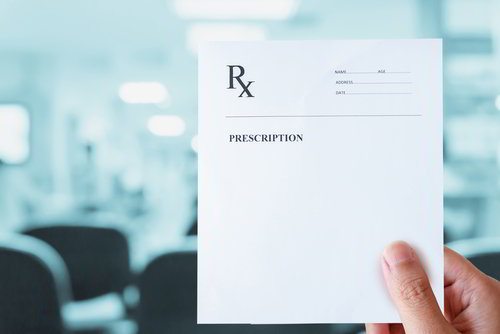
HS 11162.5 is the California statute governing fake prescription blanks in the context of controlled substances.
California Health and Safety Code § 11162.5 HS makes it a crime to possess counterfeit prescription blanks for controlled substances. This can be charged as a misdemeanor or a felony and is punishable by up to 3 years in jail or prison.
The language of the code section reads as follows:
11162.5. (a) Every person who counterfeits a prescription blank purporting to be an official prescription blank prepared and issued pursuant to Section 11161.5, or knowingly possesses more than three counterfeited prescription blanks, shall be punished by imprisonment pursuant to subdivision (h) of Section 1170 of the Penal Code or by imprisonment in a county jail for not more than one year.
(b) Every person who knowingly possesses three or fewer counterfeited prescription blanks purporting to be official prescription blanks prepared and issued pursuant to Section 11161.5, shall be guilty of a misdemeanor punishable by imprisonment in a county jail not exceeding six months, or by a fine not exceeding one thousand dollars ($1,000), or by both that fine and imprisonment.
Our California criminal defense attorneys will discuss the following in this article:
- 1. Is it a crime to have a counterfeit prescription blank?
- 2. Are there defenses to Health & Safety Code 11162.5 HS?
- 3. What are the penalties?
- 4. Related Offenses
1. Is it a crime to have a counterfeit prescription blank?
Yes. California Health and Safety Code 11161.5 HS states that:
Prescription forms for controlled substance prescriptions shall be obtained from security printers approved by the Department of Justice.1
To prove the elements of this crime, the D.A. has to show that you either:
- counterfeited one of these prescription forms; or,
- knowingly possessed a counterfeited prescription form.2
“Counterfeit” means to make an exact imitation of something with the intent to deceive or defraud.3
1.1. Meaning of “prescription blank”

A controlled substance is a drug or chemical whose manufacture, possession and use are regulated by the government under the United States “Controlled Substances Act”.
Health and Safety Code 11162.5 specifically uses the term “prescription blank” in its language and not “prescription form.” The terms have the same meaning.
They are what a medical practitioner uses when ordering or authorizing a prescription for a controlled substance. Prescription blanks/forms are also referred to as “prescription pads.”
1.2. Examples of 11162.5 HS violations
- During a routine doctor’s visit, Michelle steals a prescription pad from the medical office. She later copies it identically and writes herself a prescription for the opioid Vicodin to trick her pharmacist.
- Mark is so impressed by Michelle’s work, that he buys a counterfeit pad from her and puts it in his pocket for later use.
- Trying to earn extra money, nurse Carol takes a few prescription blanks from work, copies them exactly, and sells them to others.
2. Are there defenses to Health & Safety Code 11162.5 HS?
Here at Shouse Law Group, we have represented literally thousands of people charged with drug-related offenses such as possession of counterfeit prescription blanks for controlled substances. In our experience, the following three defenses are very effective with prosecutors, judges, and juries.
- You had no intent to deceive or defraud. This is our most successful defense because the D.A. has no way to definitively prove what was going on in your head. We can argue that you counterfeited the prescription form for the sake of art or just for the sake of doing it, and often the D.A. has insufficient evidence to refute us.
- You did not knowingly possess the counterfeited prescription blank. Unless the D.A. can prove that you knew the pad was on your person or within your control, no crime occurred. For example, the charge should be dropped if we can raise the reasonable possibility that someone planted the pad on you or left it in your home without your knowledge.
- The police entrapped you. If an undercover officer pressured you into violating HS 11162.5 – and you would not have done so but for their pressure – then the police broke the law by committing entrapment. Undercover police wear hidden audio bugs, and we can use this evidence to show that you were not predisposed to breaking the law and only did so because the police harassed or threatened you.
Note that sometimes we can stop criminal charges from even getting filed to begin with through a “prefile intervention.” If you contact us right after your arrest, we can reach out to the prosecutors and try to show them that they have insufficient evidence to sustain a conviction. If we are successful in persuading them, the criminal case ends before it can even begin.

Under HS 11162.5(a), offenses carry up to three years of imprisonment.
3. What are the penalties?
Violating California Health and Safety Code 11162.5 HS is a wobbler, meaning it can be punished as either a misdemeanor or a felony.
HS 11162.5(a) applies to the crimes of:
- Counterfeiting prescription blanks, and,
- Knowingly possessing more than three counterfeited prescription blanks.4
Under HS 11162.5(a), these offenses are punishable by imprisonment for up to one year in a county jail, if charged as misdemeanors. If charged as felonies, the crimes are punishable by imprisonment in a county jail for a term of:
- 16 months;
- Two years; or,
- Three years.5
HS 11162.5(b) applies to the specific crime of knowingly possessing three or fewer counterfeited prescription blanks.6 The section states that the crime is a misdemeanor punishable by:
- Imprisonment in a county jail for up to six months; and/or,
- A fine of up to $1,000.7
4. Related Offenses
Like HS 11162.5, the following offenses can be charged as either misdemeanors or felonies:
- Prescribing a controlled substance without a medical purpose (HS 11153) – “prescription fraud”
- Prescribing a controlled substance without treatment (HS 11154(a)) – prescribing drugs to a patient not under your care
- Prescribing a controlled substance to an addict (HS 11156) – prescribing, administering, or dispensing drugs to someone suffering from addiction
- Doctor shopping (HS 11173) – using fraud or deception to obtain drugs by way of a prescription
- Forging a narcotic drug prescription (HS 11368) – forging or altering a prescription, possessing drugs obtained through a forged prescription, or using a forged prescription to obtain drugs
- Forging or altering a prescription (BPC 4324) – forging or altering a prescription, signing someone else’s name on a prescription, or possessing drugs obtained with a forged prescription
- Forgery (PC 470) – falsifying a signature or seal or counterfeiting documents with fraudulent intent
Additional resources
For a deeper dive into prescription fraud issues, refer to the following:
- A Pharmacist’s Guide to Prescription Fraud – A guide by the Drug Enforcement Administration of what practitioners should look out for when filling prescriptions.
- Signs of prescription medication fraud and how to stop it – Article by Blue Cross Blue Shield on how to detect prescription fraud.
- Doctor Shopping Laws – Overview by the Centers for Disease Control and Prevention of what doctor shopping is and how it is punished.
Legal References:
1. California Health and Safety Code 11161.5(a) HS.
2. California Health and Safety Code 11162.5 HS. Cited in People v. Gandotra (Court of Appeal of California, Second Appellate District, Division One, 1992) 11 Cal. App. 4th 1355; People v. Demery (Court of Appeal of California, Second Appellate District, Division Four, 1980) 104 Cal. App. 3d 548.
3. 18A Ca Jur Criminal Law: Crimes Against Property § 449.
4. California Health and Safety Code 11162.5(a) HS.
5. See same.
6. California Health and Safety Code 11162.5(b) HS.
7. See same.
